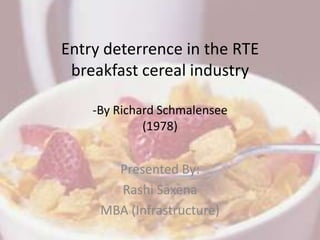
Entry deterrence in the RTE cereal industry
- 1. Entry deterrence in the RTE breakfast cereal industry -By Richard Schmalensee (1978) Presented By: Rashi Saxena MBA (Infrastructure)
- 2. Arguments about Industry conduct Avoid price competition Entry deterrence & Profit protection New brand introduction
- 3. RTE Cereal Market in U.S. • Highly concentrated post-war • Kellogg, General Mills, General Foods, and Quaker Oats: 85% of sales • Top six firms: 95% of sales • 1940-early 1970s: no new producers of RTE cereal attained significant market shares • Early 1970s: – Overall demand growth slackens – New firms entered; national marketing of so-called natural cereals
- 4. Timeline 1950-mid 1960s: Rapid and steady growth in RTE cereal sales Early 1970s: Entry of new large firms in RTE cereal market Apr 1972: U.S. FTC charges 4 U.S. RTE cereal manufactures of “Brand Proliferation, Product Differentiation, Trademark Promotion…resulting in high barriers to entry into the RTE cereal market Apr 1976-Jan 1978: Trial period Feb 1976: Quaker Oats dismissed from the case
- 5. Some ‘facts’ taken as given… • Entry Eligibility • Brand-specific production knowhow • Clear product differentiation • Advertising sales ratio>10% (Glossary) • Absolute capital costs~ $80-150 M (Glossary)
- 6. Assumptions C(q): Cost of producing • Increasing Returns at brand level and marketing a brand – C(q) = F + v.q F, v: Positive constants – Introductory advertising cost is independent of its subsequent sales – Intensity of advertising one brand vs. another • Localized Rivalry – “Variations in consumer taste give rise to product differentiation” – Brand patronizing also depends on distance proximity – ‘Localized Oligopoly’ – Hence, marketing plans stress more on the actions of only a few rivals
- 7. …continued • Relative Immobility – Economic space vs. Geographic space: If brands differ only in their locations, then changes in location are not costless – Re-positioning costs: Cost of moving an old brand to an arbitrary location vs. cost of introducing a new brand
- 8. Static Theory of Entry Deterrence • N brands Brand N Brand 1 • Distance between 2 Buyer consecutive brands: 1/N Brand… Brand 2 • Price charged: p • Buyers patronize the Buyer Unit Buyer ‘closest’ brand (≤N/2) circumference • q(p,N) = a(p).b(N) Brand 6 Brand 3 • Total sales of product do not fall as no. of brands Brand 5 Buyer Brand 4 increase • ∏ (p,N) = A(p).b(N)-F A(p)= (p-v).a(p); • ∏(p,Ń)=0 All brands p>v are profitable if N<Ń
- 9. Another assumption… • Established sellers collude to deter entry at minimum cost to themselves • Methods used to create barriers to entry: – Increase no. of brands instead of using limit- pricing policy – Increase promotional outlays in the face of threatened entry
- 10. Problems with Limit Pricing • Entrants are more crowded after entry than are established firms before entry • Forgoing short-run profits to impose greater costs on potential entrants in collective interest of established brands • If entry still occurs, it is relatively immobile • Now, profits can be generally raised by increasing prices • Limit pricing ceases to be an effective deterrent
- 11. Effect of Advertising d(F) is an increasing F: Expenditure by all • q(p,N,F) = a(p).b(N).d(F) function brands on advertising • Advertising expands sales in direct proportion to its market area • Higher maintenance spending by established brands would raise the level of introductory spending an entrant must do to get noticed
- 12. When to crowd the Economic space? • After • Before – Threat to surround an – Entry deterring threat is entrant with new brands that “brands will not be – Mutually damaging moved if entry occurs” warfare – Since repositioning – Poor credibility brands is not costless, – Higher credibility
- 13. Application to RTE Cereals Industry • The assumptions of perfect collusion and static market must be appropriately relaxed • So, consider the 3 following questions: – Could such a pattern of deterrence have arisen in the absence of such coordination? – How could the entry of new firms have been deterred, even though established firms found it profitable to launch new brands? – Is the explanation advanced here for lack of entry during 1950-60s consistent with the appearance of new firms in this market in the early 1970s?
- 14. Question 1 • Price competition was suppressed and possibly ‘cooperative’ • Rivalry was channeled into advertising (probably non-cooperative) and new product introductions (surely non-cooperative) – Private label brands were discouraged – Information exchanges through Nielson until 1972
- 15. Question 2 Two Reasons: 1. Differential expectations: At any point in the segment’s growth, the expected value of a new brands is less to potential entrants than to established sellers. Ceteris paribus, existing firms that have a modus vivendi with the major rivals find new brand introduction profitable.
- 16. 2. Minimum efficient firm size: A potential entrant would need 3% of market share to produce efficiently, while an existing firm can do with 1% The research task of potential entrants is distinctly harder than those of established sellers
- 17. Question 3 • After a rise in consumer interest in “health foods”, the natural cereals’ market share had increased steadily: – 1972: all collective market share of all natural cereals was 0.5% – 1973: 4% – 1974: 10% • The shifts in consumer taste were poorly anticipated by most of the established firms. Hence, a substantially new market was up for grabs!
- 18. Thank You
